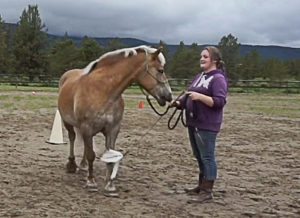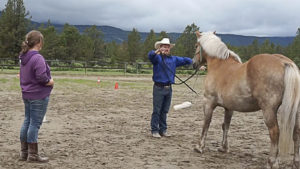Many people interpret nipping or biting as dominance on the horse’s part, and the proposed solution usually centers around getting more forceful with the horse or making him run circles until he shows signs thought by many to indicate “submission”. I interpret this whole situation a bit differently.
The way I see it, the horse that bites is seeking interaction and is asking for clarification in the relationship through spatial communication. While we generally see this as “rude”, the horse simply has a need that is not being met. All horses need us to be able to speak to them spatially, and they need us to do this in a clear and consistent manner. When we fail to meet this need, the horse ends up confused by our mixed signals and struggles to understand how they are supposed to relate to us.

Horses that bite usually have no real wish to be “dominant”; they are simply looking for clarification in your spatial relationship.
Actions like biting or kicking are common results of this struggle. Most of the time, the horse truly has no desire to be dominant – they are simply asking for clarity or have become frustrated because we are not providing that for them. A frustrated horse can become a dangerous one, so we definitely have to address this, but understanding the cause can help you find the best way to work through the issue. We can give the horse what it is seeking and build a better relationship by redefining the spatial dynamic to eliminate confusion. I find that by doing this, you don’t have to specifically address the horse’s unwanted behaviors (biting, etc.) at all, as they simply go away once you have met the horse’s spatial needs.
One way you can work on this is to start by having the horse loose in a round pen, as creating some distance between you and the horse can reduce the spatial tension created by close proximity. Working from a distance with calmness and patience, I ask the horse to move forward, turn, and stop with specificity and purpose. I achieve this by owning my own space and directing the horse with a judicious use of pressure. This means always using as little pressure as possible to effect the change you are asking for, and seeking to release that pressure at the earliest possible moment.
When you are doing this work, some horses will need very little pressure, and some may need more at first, but either way, if it is being done well, clarifying the spatial dynamic bears no relation to punishment, force, or discipline, and it carries none of the emotions entangled with those concepts. I do not make the horse to run laps, and I am not looking for the horse to “submit”. I am simply looking for the horse to indicate that he feels good about our newly established spatial communication, which means he is able to be calmly attentive and yield space without tension. Ultimately, I am looking to bring peace to the horse, both mentally and physically, and peace is not a result of a horse giving in, but rather a result of a horse giving you his trust and complying with your requests because you are meeting his needs.
.As for what you should use to apply pressure, your most important “aid” is always your own energy. But bringing up your energy and projecting that energy into the space does not mean you have to be running around or waving your arms. You can stand perfectly still while projecting your energy in a way the horse will feel and respect. This is what I mean by “owning your space.”

Josh worked with this nippy horse by concentrating on empowering his own space. He did not specifically address the biting at all, but once he clarified the spatial relationship, the biting just stopped. You may find it easier to start such work with your horse loose in a round pen.
Sometimes, though, we will need an external aid to help emphasize what we are projecting to the horse, especially at first. In these instances, I like to use a flag, which I make out of a fiberglass stick with a plastic bag tied to the end. A flag like this is very light and easy to use, allows for great variability, and provides both visual and audible cues for the horse. Whatever aid you use, it is very important that you only use it to back up what you are projecting with your energy, not instead of using your energy, or you will always need that aid and will likely dull the horse to it very quickly.
Once the spatial dynamic is well defined from a distance, meaning that you can easily and calmly direct your horse without him pushing on your space, you can slowly close the distance and focus on maintaining the same clarity. Later, you can put the horse on a line and do the same things. Try not to create a defensive environment by focusing on the nipping; focus instead on a clean spatial expression, and the nipping is likely to just disappear. Remember that the nipping itself is not the problem—it is merely a symptom of unclear or inconsistent spatial communication.
Josh Nichol

Love that you focus on the underlying need that drives that behavior, focusing on the needs of the horse certainly contributes to making it less “personal”. It’s a unique way (among many) that they use to communicate with a species that is not their own.
#coolblog
This thinking has completely changed the dynamic with my gelding. Once I saw nipping as seeking interaction rather than naughtiness, not something that needed to be corrected, everything changed. What he was saying to me was, “Let’s play!” just like he does with his equine friends. Reprimanding him with an elbow up or a smack meant to him a nip back — invitation accepted. I noticed that when the other horses didn’t want to play they turned away. So yes, space is the key — a lesson straight from the source!
The few people who come by my place aren’t allowed to pet him on the head. If they do he spirals right back into the biting behavior taking a day or two to get back to our peace.
I liked this. Have a horse that I finally figured out how to use this method with after he bit several people and myself. Has taken me a few years to figure this out but it is so like what you have just explained.
I love this article and hope it appears in Canadian Horse, or is it Horse Canada. I like the explanation on working with a horse in the round pen. I do not have a problem with this with my horse but every once in a while I can tell she wants to nip. It is done in such a way I know she is being friendly as you mention in your article. Before she gets that good nip in, and I do appreciate her offer, I stop, scratch behind her ears and explain why she cannot nip. Nic tended to strike because he was frustrated. He could have hit me but did not so I understood it was a plea for clarity. I stopped and talked to him and said I would do better. Everything we learn from you is a building block. I have heard you talk about space for a long time. This blog makes clearer yet. Thank you.
Love this! I had a nippy horse and Josh helped us address this. Great stuff!